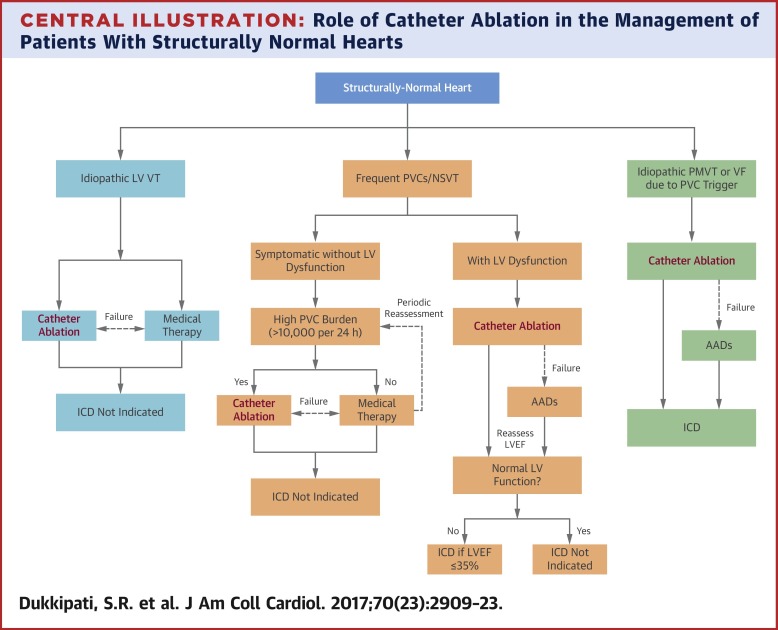当前位置:
X-MOL 学术
›
J. Am. Coll. Cardiol.
›
论文详情
Our official English website, www.x-mol.net, welcomes your
feedback! (Note: you will need to create a separate account there.)
Catheter Ablation of Ventricular Tachycardia in Structurally Normal Hearts
Journal of the American College of Cardiology ( IF 21.7 ) Pub Date : 2017-12-01 , DOI: 10.1016/j.jacc.2017.10.031 Srinivas R. Dukkipati , Subbarao Choudry , Jacob S. Koruth , Marc A. Miller , William Whang , Vivek Y. Reddy
Journal of the American College of Cardiology ( IF 21.7 ) Pub Date : 2017-12-01 , DOI: 10.1016/j.jacc.2017.10.031 Srinivas R. Dukkipati , Subbarao Choudry , Jacob S. Koruth , Marc A. Miller , William Whang , Vivek Y. Reddy

|
Catheter ablation of ventricular tachycardia (VT) is being increasingly performed; yet, there is often confusion regarding indications, outcomes, and how to identify those patient populations most likely to benefit. The management strategy differs between those with structural heart disease and those without. For the former, an implantable cardioverter-defibrillator (ICD) is typically required due to an elevated risk for sudden cardiac death, and catheter ablation can be used as adjunctive therapy to treat or prevent repetitive ICD therapies. In contrast, VT or premature ventricular contractions in the setting of a structurally normal heart carries a low risk for sudden cardiac death; accordingly, there is typically no indication for an ICD. In these patients, catheter ablation is considered for symptom management or to treat tachycardiomyopathy and is potentially curative. Here, the authors discuss the pathophysiology, mechanism, and management of VT that occurs in the setting of a structurally normal heart and the role of catheter ablation.
中文翻译:

结构正常心脏室性心动过速的导管消融
越来越多地进行室性心动过速 (VT) 的导管消融;然而,在适应症、结果以及如何识别最有可能受益的患者群体方面,常常存在混淆。结构性心脏病患者和非结构性心脏病患者的管理策略不同。对于前者,由于心源性猝死风险升高,通常需要植入式心脏复律除颤器 (ICD),而导管消融可用作辅助治疗,以治疗或预防重复性 ICD 治疗。相比之下,在心脏结构正常的情况下,VT 或室性早搏发生心源性猝死的风险较低;因此,通常没有 ICD 的迹象。在这些患者中,导管消融被考虑用于症状管理或治疗心动过速,并且可能治愈。在这里,作者讨论了发生在结构正常心脏的 VT 的病理生理学、机制和管理以及导管消融的作用。
更新日期:2017-12-01
中文翻译:

结构正常心脏室性心动过速的导管消融
越来越多地进行室性心动过速 (VT) 的导管消融;然而,在适应症、结果以及如何识别最有可能受益的患者群体方面,常常存在混淆。结构性心脏病患者和非结构性心脏病患者的管理策略不同。对于前者,由于心源性猝死风险升高,通常需要植入式心脏复律除颤器 (ICD),而导管消融可用作辅助治疗,以治疗或预防重复性 ICD 治疗。相比之下,在心脏结构正常的情况下,VT 或室性早搏发生心源性猝死的风险较低;因此,通常没有 ICD 的迹象。在这些患者中,导管消融被考虑用于症状管理或治疗心动过速,并且可能治愈。在这里,作者讨论了发生在结构正常心脏的 VT 的病理生理学、机制和管理以及导管消融的作用。











































 京公网安备 11010802027423号
京公网安备 11010802027423号